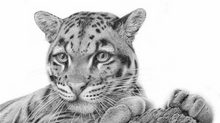The Amur leopard, aka the Manchurian leopard...
- Jon Isaacs
- Feb 24, 2021
- 3 min read
Updated: May 24, 2024
Visitors to zoos are usually thrilled to see big cats including the leopard. Few, however, in zoos such as Colchester, Edinburgh, and Marwell, realise that the animal they are looking at is not the successful predator of the African plains and forests, but the rarest big cat in the world, the Amur leopard.
The Amur leopard, also known as the Manchurian or Far Eastern Leopard, is superbly adapted to life in the harsh environment of a temperate forest habitat. It has longer legs and a thicker fur coat than other sub-species and can cope with the snow it encounters. In colour, it has a pale coat with wide rosettes with darker centres, and its eyes are light blue-green. As such, it is one of the most attractive leopard species.

The Amur leopard used to be widespread, being found in Russia, China, and Korea. However, it has suffered many threats leading to a substantial decrease in its range. Whilst there may still be occasional animals in China, it is thought to be extinct in Korea and has only one known viable breeding population of approximately thirty animals in Primorsky Krai, Russia. It is officially designated “critically endangered” with less than fifty remaining in the wild.
Poachers, hunting for its skin, are only one of the problems it faces. It is also caught in snares set for deer and other mammals. Its prey, primarily Roe and Sika deer supplemented by boars, hare, badgers, wild-bred, and raccoon dogs are also hunted by humans whilst its habitat is frequently damaged by fire and deforestation. The leopard increasingly faces the threat of incursion into its forests by companies drilling for oil and gas, as well as the construction of pipelines and roads. There are also fears that, due to the few animals still in the wild, inbreeding could become a problem.

However, all is not lost. There are approximately three hundred Amur leopards held captive within zoos in Russia, the rest of Europe including the U.K. and North America. They breed reasonably well and stud books are held to try and keep the gene bank as diverse as possible. This is important as all of the captive animals are thought to be descended from only nine individuals. There is talk of some wild bred leopards being caught to help widen genetic diversity. Another possible conservation idea is to reintroduce captive-bred Amur leopards to a reserve in Russia, such as Lazovsky. The W.W.F. runs an “Adopt an Amur Leopard” campaign to raise money and secure habitat for the species, as well as create anti-poaching teams and establish educational programmes. As it is vital that people who live in close proximity to the leopard are also encouraged to support it, funds are being made available to recompense farmers for livestock killed by Amur leopards.

In 2021, Amur leopards continue to breed well in zoos. Marwell has bred several over the years and the young have been dispersed to breeding collections in Europe and even the USA. Marwell itself currently has only one, an aging male called Akin but it is hoped, that in the not too distant future, that Marwell will again have the patter of tiny kitten paws in their leopard enclosure.
Within the world of wildlife art, the Amur leopard is a popular subject. David Dancey-Wood has superbly captured, in exquisite detail, a typical Amur leopard pose and this sought-after print can still be obtained directly from Wildlife Sketches.














































Comments